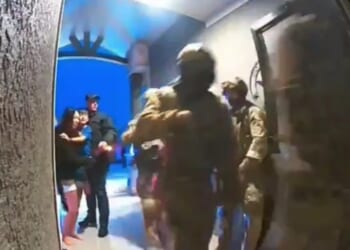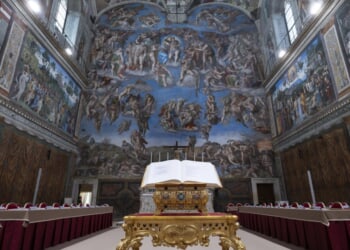Syrian president Ahmed al-Shara will need to show commitment to stabilizing the country and integrating its regions, while the United States may find it has more leverage now by embracing Damascus.
During a speech in Saudi Arabia on May 13, President Donald Trump said that he would work to end sanctions on Syria. He followed up his vow by meeting with Syria’s new President, Ahmed al-Shara. These were momentous days for the new government in Damascus, raising hopes for a better future in the war-torn country. However, Syria still has many challenges closer to home, and sanctions relief may take time to show positive results.
Trump’s decision to end sanctions and meet with Shara came about due to talks with Saudi Arabian crown prince Mohammed bin Salman and Turkish president Recep Tayyip Erdogan. It also came in the wake of a successful April visit to Syria by two members of Congress, Representatives Marlin Stutzman (R-IN) and Cory Mills (R-FL).
With increasing support from the United States, Syria will have a chance to work more closely with Western powers. This will enable it to rely less on China or countries that are hostile to the West. For Washington, Trump’s decision to end sanctions provides an opportunity for more influence in Damascus and also a possible withdrawal of U.S. forces stationed there. This matters because Syrians likely want backing from the United States. There is a window of opportunity to leverage the new ties and create a vision for Syria that builds on the first five months of the new transition government’s progress.
The rapid American shift on Syria has come about in large part because of transformations in Damascus. Ahmed al-Shara, a leader of Hayat Tahrir al-Sham (HTS), led fighters into Damascus on December 8 as the Assad regime collapsed. Fifty years of one-family rule was over, but Syria was still divided.
The group led by Shara has past connections to extremists, and Shara was once imprisoned in Iraq when he was a supporter of Al Qaeda. He has sought to distance himself from that era and transform HTS into a party of governance in Idlib in Syria, an area it ran for many years. Shara created a transition government, and non-HTS members, including a Christian woman and members of the Druze, Kurdish, and Alawite minorities, now lead around half the government ministries.
Shara has proven adept at diplomatic outreach. Shortly after assuming power, he traveled to Saudi Arabia, followed by a visit to Turkey. He has balanced the different power centers in the Middle East by reaching out to both Qatar and the United Arab Emirates. He has also mended relations with Jordan and Egypt. On May 7, Shara traveled to Paris for his first European visit.
This hasn’t always been the case in other countries that sought to transition after the 2011 Arab Spring. For instance, after the fall of Egyptian president Hosni Mubarak in 2011, his successor, Mohammed Morsi, left Egypt divided and chaotic. In 2013, Popular protests and the army overthrew Morsi. Muammar el-Qaddafi was killed in Libya, and those who jockeyed for power in his wake never created a unified state. It is no surprise that none of the names of the post-Qaddafi leadership became well known because none of them succeeded in doing much outreach outside of Libya.
Trump has hope for the future of Syria. “In Syria, which has seen so much misery and death, there is a new government that will hopefully succeed in stabilizing the country and keeping peace,” he said in Saudi Arabia on May 13.
Trump has had an interest in Syria since his first term. He sought to withdraw U.S. forces from the country in 2018 and 2019. Hundreds of American troops are in Syria backing the Syrian Democratic Forces (SDF), a mostly Kurdish-led force that defeated ISIS in eastern Syria. This was an incredibly successful mission, accomplished with minimal resources and a small number of troops.
The U.S. role in eastern Syria had provided America leverage over developments in the country. This role was generally opposed by Russia and Iran, as well as by Turkey. Turkey opposes the SDF because it says the SDF is linked to the Kurdistan Workers Party (PKK), a terrorist group. Now, the PKK says it will dissolve itself. This could reduce a thorn in the side of U.S.-Turkey relations.
Trump is close to Erdogan and would likely appreciate having tensions over U.S. backing of the SDF put on the back burner. Developments in Syria now enable this to happen. The SDF leader, Mazlum Abdi, flew to Damascus in early March and met with Shara. They agreed to integrate the SDF into Syria’s new security forces. Now, U.S. support for Syria could enable a successful draw-down of troops.
U.S. training for Syrian forces over the last decade may help secure the future of Syria. The SDF in eastern Syria is a US-trained armed force and, as such, would provide Damascus with a competent force that amounts to several divisions worth of light infantry and several regiments of elite counter-terrorism units.
The United States also trained the smaller Syrian Free Army based at Tanf in southern Syria. This force conducts patrols and helps stabilize southern Syria near the Iraqi border. “We welcome the lifting of sanctions on Syria. Thank you for giving Syria a great opportunity to rebuild and support stability and security,” the Syrian Free Army said after Trump’s speech.
This means that the new policy of sanctions relief and U.S.-backed forces in Syria now provide key elements of how Syria can prosper. They also enable influence over where Damascus goes next. Some have expressed skepticism regarding whether Shara and his allies are ready to have an inclusive, democratic Syria. History shows that if there is a vacuum in power or influence, then others will fill it.
Shara has sought to balance engagement with the regional powers, not becoming beholden to any one of them, whether Turkey, Qatar, Saudi Arabia, or the UAE. A decade and a half of fighting in Syria during the Syrian Civil War likely taught him how most of the countries that intervened in Syria did not have Syrians’ best interests at heart, or at least did not contribute to peace and prosperity via military intervention. It’s clear that the Ankara-controlled parts of northern Syria, for instance, are not prosperous or stable. Eastern Syria has been cut off from investment for many years.
Much work remains, and there are major challenges ahead. Trump’s decision to end sanctions and the recent visits by members of Congress show that Washington believes engagement with Damascus can lead to positive outcomes. Shara will need to show commitment to stabilizing the country and integrating its regions, while the United States may find it has more leverage now by embracing Damascus.
About the Author: Seth Frantzman
Seth Frantzman is the author ofDrone Wars: Pioneers, Killing Machine, Artificial Intelligence and the Battle for the Future (Bombardier 2021) and an adjunct fellow at The Foundation for Defense of Democracies. He tweets at @sfrantzman.
Image: Berit Kessler / Shutterstock.com.














